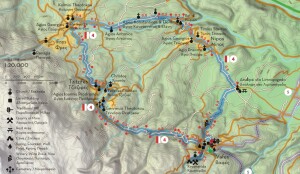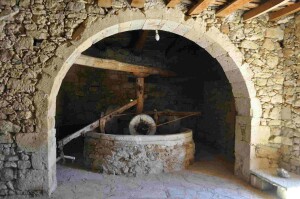Paths of Apokoronas (Route 4)
Route 4: The cypress villages
Vafes - Tzitzifes - Fres - Nipos - Limnopigado - Vafes
Total length: 11 km (the main route), estimated time 4h 45΄
Part A: 5 km, estimated time 2h 10΄
Vafes - Tzitzifes - Fres
Route 4 connects some of the most picturesque villages of the foothills of the White Mountains (Riza), which could not be left out of the network of paths of Apokoronas. Although this route is circular, Vafes has been designated as its a starting point, due to the fact that Route 5 also passes through the village. It should be noted however that all four villages (Vafes, Tzitzifes, Fres, Nipos) of the route have cafes and shops that operate all year round, which makes them ideal for stopping or refueling during the hike.
Vafes is estimated to have been founded in the mid-8th century, when neighboring Kourtsa was destroyed by the Arabs and many fled to this location. During the 12th century, the Skordilis family settled in Vafe, which was recognized as noble during the Venetian period. After the conquest of Apokoronas by the Ottomans in 1646, Vafes became property of a Muslim public benefit institution (vakıf) connected to the mosque of Fındık Haji Mehmet Pasha in Heraklion (Kandiye). Several noteworthy buildings were built this period, such as the two-aisled church of Christ, the residence of the priest Emmanuel Skordylis of 1745 and a series of vaulted structures attributed to the janissary Ibrahim Alidakis. About 400 meters away, visitors can find the cave of Kryonerida, which served several times as a refuge for Christians, but was discovered in August 1821 by the Ottomans, who lit a fire at its entrance, causing death by suffocation to about 130 women and children that had hidden inside it.
From Vafes the route continues west following the foothills of the mountain to Tzitzifes, which you should find after 2.5 km. The first building you will encounter is the church Gennesio tis Theotokou (Birth of Virgin Many), shortly after which you will turn right at the cemetery and descend to Agios Ioannis Prodromos, near the center of the village. Following the signs from here you will descend to the lower side of the ravine that separates the two neighborhoods of the village and is known as Faragouli, reaching the fountain of Vrisi (200 meters below), where many important meetings of Cretan rebels took place in the 19th century. It should be noted that Tzitzifes is the only village in Crete where karabassi is still produced, an essential oil produced from laurel which has healing as well as ornamental properties.
Leaving Tzitzifes behind, head north northwest following a dirt road on a lower level than the paved road to Fres, reaching its main square after 1.6 km. A small road that starts from “Kamaraki” leads to the church Panagia ton dyo Vrachon (Madonna of the two Rocks), a picturesque church of the 13th century, while the school of the village hosted the Pancretan Revolutionary Assembly from November 1877 to late January 1878. Two other points of interest in the village are the Giannoulakis Municipal Gallery and the impressive church of Panagia Evangelistria, which was built during the period 1856-1938 and is a typical example of modern ecclesiastical architecture with remarkable wall paintings. At Fres you can also find several options for food or coffee, or alternatively “refuel” and continue on to part B returning to Vafes via Nipos.
Part B: 6 km, estimated time 2h 35΄
Fres - Nipos - Limnopigado - Vafes
Part B runs at a lower altitude than Part A, but includes several points with excellent views of the villages of Riza and the White Mountains (Lefka Ori). Starting from Fres, you will look for the crossroads near the northern entrance of the village to the churches of Michael the Archangel and St. Anthony. Continuing on the same dirt road, a few kilometers east you will find the church of Saints Constantine and Helen and half a kilometer below the Rafioli spring, which has always been a meeting point for the Nipians, both for its gurgling waters and the landscape of special of natural beauty around it.
From here you will ascend to Nipos, which is less than 700 meters away. According to Xanthoudidis, this area used to be a grazing site for horses (ippos in ancient Greek), where a sanctuary was later built. Its name was Ippokorónion, which later evolved to Apokoronas, the current name of the province. According to another theory, the village’s name is related to the word napos, which means “plain” and was corrupted over time to Nipos. According to a third version, the village was originally named Rahi and was renamed Nippos after a Venetian official in 1550. In the center of the village you will find the churches of Timios Stavros and Agios Georgios, beautifully preserved old houses and a monument to the prominent and non-fallen of the village, such as Theoklis N. Kakatsis (Kakatsakis), Emmanuel Katsigaris-Karamanolis and the lieutenant Ioannis Kouromichelakis, who was killed in Kale Grotto of Asia Minor in 1921.
From the center of Nipos head east along the main road to Vrisses for about 300 meters and turn right (south) towards Limnopigado, a plateau 1km away where locals from the surrounding villages (mainly from Nipos and Vafes) used to come for water and socializing. At this location you can now find a small spring, a chapel dedicated to the Ascension (Analipsi) and some benches where you can rest. From here a dirt road leads east to the main road to Vafes (1 km) and Vrisses (3 km), but the route continues southwest (uphill) to Vafes, which you will reach after a 1.6 km, passing through a vineyard and entering the village from the north.
Source: Municipality of Apokoronas (2022)
























